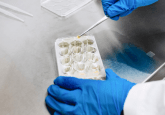Choose your cryopreservation media carefully: an interview with Oren Ben-Yosef

In this interview, Oren Ben-Yosef, Biological Industries (BI; Israel), discusses key considerations when selecting a cryopreservation media and how manufacturers are supporting developers in looking after their cells.
This interview is part of the RegMedNet In Focus on cryopreservation. Discover expert opinion and top tips for cryopreservation in the feature now.
Visit the feature
Could you introduce yourself, Biological Industries and Sartorius’ Advanced Therapies Division?
My name is Oren Ben-Yosef. I am the Stem Cells Product Manager in BI. I have a PhD in Medical Sciences from the Technion – Israel Institute of Technology (Israel) in the field of stem cell research and ophthalmology. BI has more than 35 years of experience in developing, manufacturing and supporting culture media and auxiliaries for cell culture, life science and the biotechnology Industry. BI is now part of the Sartorius group (Germany) and a significant player in the newly formed Advanced Therapy division, which provides compelling solutions for customers who are developing cell-based, gene-modified cell-based or tissue-based therapies using mesenchymal stem cells (MSCs), induced pluripotent stem cells (iPSC) and T-cells.
BI and Sartorius have joined forces to become a key scientific partner and supplier in cell therapy and regenerative medicine markets. As part of our collaborative business activities, we are currently expanding our global presence. This means that researchers around the world will now have quick and direct access to BI’s entire portfolio of optimized, innovative solutions for advanced therapies and stem cell research; as well as the opportunity to consult and collaborate with our dedicated technical experts and R&D scientists
How have the needs of manufacturers changed over recent years with regard to cell culture preservation?
As with many areas in our market, regulations are getting tighter and tighter. This requires the manufacturers to produce more defined cryopreservation solutions, for example switching to salt-based solutions rather than media-based and reducing the cryoprotectant concentrations, and to find and acquire raw materials of higher grades, moving from research-use-only to USP-grade ingredients.
Another issue is specificity of the cryopreservation solutions – as more and more cell types are being cryopreserved and used in both research and clinical applications, researchers and the industry are looking for specific solutions to handle their specific cells, and not every “homebrew” solution that fits most cell types would do.
How do methods and protocols for cell culture preservation differ depending on the type of research or clinical interventions taking place?
The methods and protocols for cryopreservation have not really changed over the years – in order to freeze cells you still have to use a cryopreservation solution containing one or more cryoprotectants, such as DMSO, the freezing rate must still be controlled and the cell have to be kept in liquid nitrogen for long periods of time.
What has changed are the specifics within each step. For instance, there are many more commercially available cryopreservation solutions out there, like our NutriFreez D10. Control of the freezing process was once done using simple containers whereas nowadays there are controlled rate freezers can do that step for you; you just have to adjust the controls to your preferred rate, the standard being -1°C per minute.
I would guess that, much like the previous question, the thing that changed the most are the regulations which the clinical industry must follow. Therefore, most of the efforts by R&D teams that develop cryopreservation solutions are focused on that field.
What are the main challenges involved in the process of cryopreservation?
The main challenges for researchers and companies in cryopreserving cells are keeping the cells viable through the process of freezing and, no less important, thawing; and having the cells recover in a timely manner and recover well. Both viability and recovery are affected by many factors, among them the cryoprotectants used, the rate of freezing and thawing, how long the cells are in transition from one step of the freezing/thawing process, etc.
Another challenge is how many cells can be frozen from an ongoing culture and in what concentration (cells/ml).
The main challenge for the cells during cryopreservation, however, is dealing with ice crystals forming both within and without the cells, and the changes in osmolarity caused due of the decrease in available water and therefore increase in salt concentrations, causing dehydration of the cells.
How can these challenges be addressed?
The challenges are interconnected and therefore dealing with one usually affects the other. One of the “easiest” factors to address the challenges is the cryopreservation solution used. Most academic researchers use “homebrew” cryopreservation media, usually composed of a certain percentage (usually 10-20%) of DMSO, as an intracellular cryoprotectant, FBS (20-40%) as an extracellular cryoprotectant, and the medium that the cells are grown in, for example DMEM, RPMI or M-199.
The trouble with that is that the concentrations of DMSO may be too high for the cells and FBS, while having a high concentration of proteins and therefore can affect the osmolarity, is certainly not a cryoprotectant and has too many variables and unknowns in it. Therefore the use of commercially available cryopreservation solutions can greatly decrease the variability of the freezing process, and as such increase the viability and recovery of the cells.
Another factor is good cell culture practices (GCCP). This is something that is practiced in most academic labs and certainly in industry, where ISO and GMP are masters, but there is still a need to do “refresher” courses and lectures in that area, because these are the basics that sometimes people forget. For instance, the dogma in cell cryopreservation is “freeze slow, thaw fast” and if you forget that you greatly decrease your cells’ survival.
What factors require consideration when choosing a cryopreservation media?
Ingredients, suitability for cell type, regulatory constraints are all key considerations. Brand name should not be a consideration. References yes, especially for researchers dealing with specific or rare cell types, but brands no.
In terms of ingredients, the percentage of DMSO can be a factor – 10%, 5% or less? – as well as the other cryoprotectants present in the medium. For instance, in our NutriFreez D10, we have methylcellulose, which acts as an extracellular cryoprotectant and replaces other, less savory ingredients like FBS.
As to what cell type the cryopreservation medium is suitable for, most companies have lists of cells that the medium has been tried on – some can be very specific, such as neural cells or non-mammalian cells, and some can be general – one fits all. Another facet of this is the QC that the medium undergoes. Each lot of NutriFreez D10 is tested on human pluripotent stem cells, mesenchymal stromal cells and Vero cells for viability and recovery.
There are also regulations when dealing with freezing cells, especially in the clinical space. While academia may be more relaxed, the industry must contend with tighter regulations. When freezing cells that are intended for human use, the regulations are very strict and there are solutions that commercial media offer that other cryopreservation media do not. A Drug Master File (DMF), for instance, is one of the highest regulatory documents that are relevant for clinical application, more so than a Biological Master File (BMF). NutriFreez D10 has both and, as an ancillary material, it can be used in the process of manufacturing clinical products and/or processes, while not being part of the final product.
What are the benefits of using a cryopreservation-specific media?
The use of specific products and media is always better than using products that are non-specific, like FBS. The more defined the medium, such as serum-free, xeno-free or even animal component-free, the better it will perform. Additionally, using an off-the-shelf media without having to prepare it fresh every time has always been an advantage that researchers who purchased our cryopreservation products state.
In what ways do you see the use of tissue and cell culture preservation evolving over the next 5–10 years?
There are two specific goals that are on the sights of all companies who develop and produce cryopreservation media: creating a DMSO-free medium and creating a cryopreservation medium that is injectable. The former is difficult because while there are DMSO substitutes, most of them are just as harmful for the cells, if not more so. This means you need to find some very specific substance. The latter is even more difficult because the regulations concerning what can be inserted into the human body are very strict; here, DMSO actually has an edge because it is used in drugs already.
What future obstacles does BI predict and what support will it offer to overcome them?
BI is always innovating and trying to predict the market, particularly in the regulatory atmosphere. We have a big R&D department and they have already developed a 5% DMSO, salt-based solution cryopreservation agent named NutriFreez D5 (to be launched soon). They are also working on a 2% DMSO cryopreservation solution and one that is DMSO-free. We also have a big QA/RA department to deal with the regulations regarding cryopreservation, including applying and receiving DMFs for our products.
If people would like more information, how can they contact you?
We are always happy help and offer from our expertise and we can be contacted by this e-mail: [email protected] or by my personal e-mail: [email protected]





